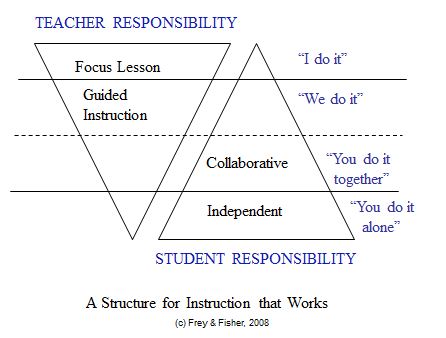At Carbrook State School we strive to achieve the very best in instruction by utilising high yield instructional strategies that are well researched and employed in high performing schools all around the world. One whole school instructional model employed across P – 6 is the gradual release of responsibility model. This is a broadly recognised successful approach for moving classroom instruction from teacher-centered, whole-group delivery to student-centred collaboration and independent practice. You may hear the kids refer to this model as the I DO, WE DO, YOU DO. This model proposes a plan of instruction that includes demonstration, prompt and practice.
This diagram from the work of Doug Fisher and Nancy Frey (2007), shows the specific stages of this instructional approach. Taken as a whole, the triangles represent the mentoring relationship and two way interaction between teacher and student. At the beginning of a lesson or when new material is being introduced, the teacher has a prominent role in the delivery of the content. This is the "I do phase". The teacher explicitly models the skills and strategies necessary to learn new content.

But as the student acquires the new information and skills, the responsibility of learning shifts from teacher-directed instruction to student processing activities. In the "WE DO" phase of learning, the teacher continues to model, question, prompt and cue students; but as the student moves into the "YOU DO" phases they rely more on themselves and less on the teacher to complete the learning task.

Checking for Understanding
Throughout the gradual release of responsibility model of instruction, teachers are continually checking for understanding. Mini whiteboards that each student possesses (as per the booklist) are used as a visual method of checking for understanding. On teacher's cue, each student holds up an individual whiteboard (or similar device) on which he or she has written a response to a question or prompt. Unlike other Checking For Understanding methods, in which teachers make an inference about student learning from a sample of students, with whiteboards, the teacher visually records answers from the entire class. Generally, checking for understanding using Whiteboards is most effective when the responses are short so that the teacher can scan the responses from all students relatively quickly (e.g., the answer to a computation problem, a single word or short phrase, an arrow pointing to a specific part of a sketch).
What and when to Check For Understanding comes at a critical moment in the lesson; the teacher is intentionally finding out about the "right stuff" at the "right time." This method allows the teacher to make an unbiased (or less biased) inference about the student's understanding of concepts. The teacher leverages the Checking For Understanding data in the moment to determine the next instructional move (e.g. continue with the lesson, pinpoint a particular misunderstanding, reteach the concept).